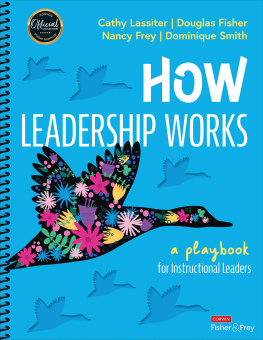CONTENTS
Guide
Sandy Brunet, Carin Fractor and Marine Freibrun
From the founders of The Intentional Principal
Leading with Administrator Clarity
School-Wide Strategies for Cultivating Communication, Fostering a Responsive Culture, and Inspiring Intentional Leadership
Text copyright 2022 Sandy Brunet, Carin Fractor, and Marine Freibrun. Design and concept copyright 2022 Ulysses Press and its licensors. All rights reserved. Any unauthorized duplication in whole or in part or dissemination of this edition by any means (including but not limited to photocopying, electronic devices, digital versions, and the internet) will be prosecuted to the fullest extent of the law.
Published by:
Ulysses Press
PO Box 3440
Berkeley, CA 94703
www.ulyssespress.com
ISBN: 978-1-64604-355-2
ISBN: 978-1-64604-380-4 (ebook)
Library of Congress Control Number: 2022932300
Acquisitions editor: Claire Sielaff
Managing editor: Claire Chun
Project editor: Renee Rutledge
Editor: Pat Harris
Proofreader: Kate St.Clair
Front cover design: Justin Shirley
Cover artwork: bsd/shutterstock.com
Interior design and layout: Winnie Liu
Our Intentional Why
The principalship is more than a post,
More than a rung on the ladder
Or a safe move toward retirement.
The principalship is a calling.
The principalship means charting uncharted waters,
Iterating, ideating,
Failing forward when its easier to stay the course.
The principalship is also a balance;
When done best, it is intentional,
Planned, and purposeful.
Like the philosophers and academics before us,
We embrace our calling.
Empowered through collaboration,
Emboldened by one another,
Ready for the journey,
We lead intentionally with passion and purpose.
INTRODUCTION: THE WHY FOR OUR BOOK
Are we the only ones who have noticed that the vast majority of books written about school leadership are written by people who havent actually led a school in recent times? We want to change that. Within this book, you will find tried-and-true information, resources, and actionable guidance that you can use immediately to increase your instructional effectiveness and lead your school intentionally with passion and purpose.
We are not here to tell you that we have all the answers or that the work is easy. We wrote this book because, as school leaders, each one of us had to figure out on our own how to operationalize best leadership practices. We each read every book by Simon Sinek; we followed Bren Browns posts daily and could list the top ten effective practices within John Hatties Visible Learning research. Yet, when it came to school leadership, we independently struggled with how to articulate all those ideas our mentors and leadership gurus espoused while also keeping our schools afloat.
It was not until the three of us moved into different roles in different states, experiencing the many emotions educators face today, that we connected as thought partnerspeople who challenge your thinking and provoke you to innovate. Through this connection, we collaborated, iterated, failed, and leaned into our own vulnerabilities to be the most intentional leaders we could for our organizations. Through this process, we were able to identify how clarity within our own leadership led to more success for our staff and our students.
During the past ten years, the concept of teacher clarity has gained increased traction and attention among educators. In his 2015 study, John Hattie found the effect size of teacher clarity on student achievement to be 0.75 (or equivalent to nearly two years growth in one years time). While the importance of an effective teacher in the classroom cannot be overstated, the school leader also plays a critical role in overall school performance and achievement. We argue that having clarity as a school administrator is equally as important as having clarity as a teacher.
Therefore, clarity as an administrator is authentically delivering intentional leadership. In this book, we begin by setting a working definition of intentional leadership. As you will learn, intentional leadership is the purposeful fostering of a responsive school culture. It helps school administrators understand the myriad factors that lead to the creation of a culture that focuses on process over perfection. Intentional leadership is the combination of setting clear and high expectations, encouraging accountability, and fostering safety and trust within a school. Together, these practices can set the stage for good staff to become great and great staff to become unstoppable.
We aim to provide a how-to guide to assist aspiring, new, and veteran administrators in creating a culture that fosters student achievement by diving into the following concepts: clarity of purpose, clarity of implementation, clarity of communication, and clarity of sustainability. We infuse the text with personal anecdotes and, of course, stories of epic failures. We include current research and pedagogy and a variety of easy-to-use, vetted resources to help school administrators become more intentional in their leadership and to create a road map for leading with Administrator Clarity, a quality we define in Chapter 1.
We believe that, when taken as a whole, the information presented here can vastly improve the impact of your professional learning as well as that of the staff and students within your charge.
Chapter 1 OVERVIEW OF ADMINISTRATOR CLARITY
As we mentioned earlier, the idea of teacher clarity has been around for some time. The concept has been supported and popularized by John Hatties work on Visible Learning. According to his research, when teachers are clear in expectations and instructions, students learn more (Hattie 2012, 18). It has also been said that teacher clarity is both a method and a mindset, and that its influence on student performance can result in nearly two years growth in one years time.
What seems to appeal to both teachers and students is that teacher clarity brings a level of transparency to teaching and learning. By teachers setting clear guidelines and expectations, students can know what is expected of them. When they know what is expected, they can create a pathway to succeed and measure their own progress.
We could not help but wonder: If clarity is a key contributor to student success in the learning environment, wouldnt the same likely hold true in any environment of teaching professionals?
As school leaders, we set out to explore this idea in more depth. We posed an informal survey to a set of over one hundred educators. We asked them about their experiences as teachers when they felt most effective, when they felt most supported, and when they could best see their efficacy.
The results were neither shocking nor revolutionary. Time and again, teachers attributed their successes with their students directly and indirectly to the attributes and expectations of their school leaders. When teachers know what success looks like at their school, they are more likely to see themselves as effective, to see their students as high achieving, and to note that their students assessment scores are an accurate indicator of student learning and achievement.
Essentially, our survey told us that one of the best indicators of both teacher efficacy and teacher satisfaction was directly related to the qualities of the person at the helm of these schools. Here is where Administrator Clarity and intentional leadership come in.













